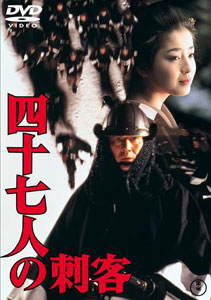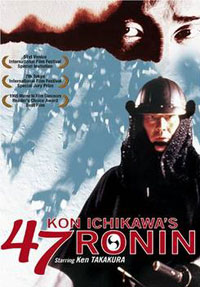 Kon Ichikawa's version of the 47 Ronin (Shijushichinin no shikaku, Toho, 1994) was released in "commemoration of the one hundred year anniversary of the birth of motion pictures." Kon Ichikawa's version of the 47 Ronin (Shijushichinin no shikaku, Toho, 1994) was released in "commemoration of the one hundred year anniversary of the birth of motion pictures."
This is a typical advertising hook for "big" & "important" but very commercial film releases suitable to the whole family, & they do generally stand as the most important of the given studio's release in the given year.
Promotion, however, frequently wins out over authentic quality, & the film's numerous awards seem to have followed after money, not art.
As the story opens, signal members of the abolished Ako Clan have gathered at an inn to go over the blueprints to the fortified mansion of Lord Kira (Ko Nishimura).
Neophytes to samurai films may wonder what is going on, but in Japan, & for anyone who has been a fan of jidai-geki for longer than a month, we know immediately we're entering the tale of the forty-seven brave ronin, but rather late in the tale.
With fearful certainty that the late Lord Asano's now masterless vassals intend to avenge their Lord, Kira has installed a garden maze of walls, a moat, & other novel features to foil an attack upon his residence. Here even viewers who know the tale well may be a bit startled, as this series of traps is not part of the usual story.
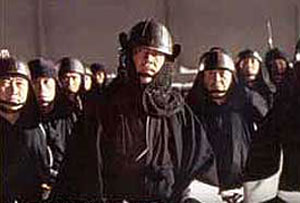 Kira's supporters have reported that Lord Asano's chamberlain, Oishi Kuranosuke (Ken Takakura), and other key players in the drama, "have gone missing." They take this as evidence that the culmination of a year & a half of planning is about to begin. Kira's supporters have reported that Lord Asano's chamberlain, Oishi Kuranosuke (Ken Takakura), and other key players in the drama, "have gone missing." They take this as evidence that the culmination of a year & a half of planning is about to begin.
And indeed, Oishi, at the secret meeting at the inn, is saying to his vassals, "If killing one's enemy is even, even knowing that by so doing we must die, then let me revel in it."
The tone is gloomy in its atmospherics. Glacial pacing requires each scene to be appreciated for its visual excellence, emotional content, & the careful dialogue which has been written at a higher philosophic level of than is the case with most versions of the tale.
We may have wondered why the story begins at the end, but soon we're in a flashback, receiving little portraits of the events leading up to the night of vengeance. The flashbacks mix mere snapshots of popular scenes together with more fully developed scenes. Unfortunately, the film gives off a reek of superficiality, for a story that usually implies greater depths.
This is not a tale ordinarily told with flashbacks, but always with a measured, even poky, but always forward momentum.
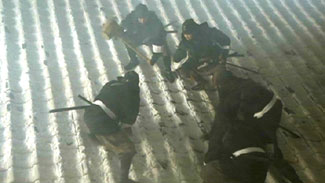 Kon Ichikawa's desire to give it a new structure is not as good an idea as he may have thought. It works much less well to retroactively fill in the "skipped" bits in a needless rearrangements of time. It's too much like looking at a set of blockprints out of order, or unrolling a story-scroll backward. Kon Ichikawa's desire to give it a new structure is not as good an idea as he may have thought. It works much less well to retroactively fill in the "skipped" bits in a needless rearrangements of time. It's too much like looking at a set of blockprints out of order, or unrolling a story-scroll backward.
There aren't many alternative takes on the familiar moments & episodes, so really it's the same old stuff shown out of order. Rearranging the timeline provides no new surprises, it just shuffles the material so that the viewer is not permitted the ritual of watching a well-known story progress toward that pre-ordained & culturally satisfying conclusion.
The story is so well known that to see it for the umpteenth time requires emersing oneself into this homage to history, to bravery, to loss & tradition. Great as Kon Ichikawa can be as a director, or was in his heyday a couple decades earlier, he truly squelched the element of ritual-viewing. And Except for the concluding traps set by Kira, there is nothing new to be seen which would justify the structure's insistence that the film be viewed from a new arrangement.
And Ken Takakura, superb as he is as a screen presence, is miscast as Oishi. Ken has one stoic sad-faced mode of expression, narrowing too much the usually complex character Oishi needs to be.
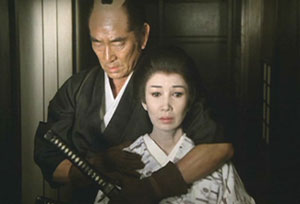 The climactic portion of the ritualized viewing -- the explosion of violence after what should be a long slow unfolding of the story -- is given some novelty by Kira's garden maze, though this one unique factor lends one to wonder why the film has nothing else novel to offer. The climactic portion of the ritualized viewing -- the explosion of violence after what should be a long slow unfolding of the story -- is given some novelty by Kira's garden maze, though this one unique factor lends one to wonder why the film has nothing else novel to offer.
The snowfall gives Edo its look of purity as the forty-seven ronin gather under cloak of night. The long march to Kira's mansion can be one of the most powerful sequences, frequently drawn out for maximum tension. Ichikawa makes of it more of a quick jog.
The assault with swords through the fortified mansion seems intentionally to have been staged as clumsy, with thick walls & gate traps inducing the lumbering pace. At length they break into the maze & despite having had blueprints for it, they curiously lack any clue as to the best route through.
The tale ends prematurely, with the vengeance completed. Since he's a fardling old fool there is really nothing brave about so many men joining together to kill one old man. The bravery is that they did it knowing they would collectively have to commit seppuku in expiation for their actions. Ichikawa has removed the spiritual climax of their punishment, preferring to end with the action climax & even one big "money shot" of Kira's geysering blood which again just undermines the significance of the moment.
In all, despite fine widescreen cinematography & spectacular art direction, plus fragments of good dialogue, this is nevertheless a weak entry in the enormous legacy of cinematic treatments of the Chushingura story.
It removes so much that is important to the tale without offering any actual alternative viewpoint. It's too incomplete, & most strangely has the feeling of having been directed by an "average" chambara director who thought a film about the brave forty-seven was just another script to be completed, not something with high cultural significance. It will likely be more impressive, but also a lot more confusing, to viewers who've never seen any of the many better versions.
copyright © by Paghat the Ratgirl
|
